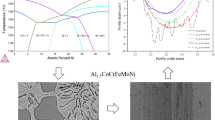Abstract
Nanoindentation was used to study incipient plastic deformation in the vicinity of grain boundaries of different character in Fe–3 mass% Si alloy bicrystals and tricrystal. Pop-in events associated with the grain boundaries were observed in the load–displacement curves. From the pop-in hardness values, the critical stresses required to propagate the yield past the grain boundary were estimated to be in the range of approximately µ/400–µ/130 (where µ is the shear modulus) depending on the grain boundary character: the special boundaries usually had higher critical stresses than the general boundaries. A Hall–Petch (H–P) type relationship was found between the hardness and the distance of the indenter to the grain boundary. The H–P slopes obtained were approximately one order of magnitude lower than the macroscopic value of the H–P slope for the Fe–3 mass% Si alloy, and were generally lower for general grain boundaries than for special boundaries.







Similar content being viewed by others
References
Hall EO (1951) The deformation and ageing of mild steel: III. Discussion of results. Proc Phys Soc B 64:747–753
Petch NJ (1953) The cleavage strength of polycrystals. J Iron Steel Inst 174:25–28
Westbrook JH, Aust KT (1963) Solute hardening at interfaces in high-purity lead—1. Grain and twin boundaries. Acta Metall 11:1151–1163
Aust KT, Hannemann RE, Niessen P, Westbrook JH (1968) Solute induced hardening near grain boundaries in zone refined metals. Acta Metall 16:291–302
Watanabe T, Kitamura S, Karashima S (1980) Grain boundary hardening and segregation in alpha iron–tin alloy. Acta Metall 28:455–463
Chou YT, Cai BC, Roming AD Jr, Lin LS (1983) Correlation between grain-boundary hardening and grain-boundary energy in niobium bicrystals. Philos Mag A 47:363–368
Kobayashi S, Tsurekawa S, Watanabe T (2005) Grain boundary hardening and triple junction hardening in polycrystalline molybdenum. Acta Mater 53:1051–1057
Kobayashi S, Tsurekawa S, Watanabe T (2005) Structure-dependent triple junction and intergranular fracture in molybdenum. Philos Mag 86:5419–5429
Wang MG, Ngan AHW (2004) Indentation strain burst phenomenon induced by grain boundaries in niobium. J Mater Res 19:2478–2486
Soer WA, Aifantis KE, De Hosson JThM (2005) Incipient plasticity during nanoindentation at grain boundaries in body-centered cubic metals. Acta Mater 53:4665–4676
Ohmura T, Tsuzaki K, Fuxing Y (2005) Nanoindentation-induced deformation behavior in the vicinity of single grain boundary of interstitial-free steel. Mater Trans 46:2026–2029
Yang B, Vehoff H (2007) Dependence of nanohardness upon indentation size and grain size—a local examination of the interaction between dislocations and grain boundaries. Acta Mater 55:849–856
Eliash T, Kazakevich M, Semenov VN, Rabkin E (2008) Nanohardness of molybdenum in the vicinity of grain boundaries and triple junctions. Acta Mater 56:5640–5652
Britton TB, Randman D, Wilkinson AJ (2009) Nanoindentation study of slip transfer phenomenon at grain boundaries. J Mater Res 24:607–615
Pathak S, Michler J, Wasmer K, Kalidindi SR (2012) Studying grain boundary regions in polycrystalline materials using spherical nano-indentation and orientation imaging microscopy. J Mater Sci 47:815–823. doi:10.1007/s10853-011-5859-z
Worthington PJ, Smith E (1964) The formation of slip bands in polycrystalline 3% silicon iron in the pre-yield microstrain region. Acta Metall 12:1277–1281
Johnston TL, Tetelman AS, McEvily AJ Jr (1965) On lattice effects and the strength of alloys. In: Zackay VF (ed) High-strength materials. Wiley, New York, pp 363–372
Tangri K, Tandon KH (1975) On the behaviour of grain boundary slip sources in Fe-3%Si steel. In: Westbrook H, Woodford DA (eds) Grain boundaries in engineering materials, Proceedings of the 4th Bolton landing conference. Claitor’s Publishing Division, Baton Rouge, LA, pp 327–338
Murr LE (1975) Some observations of grain boundary ledges and ledges as dislocation sources in metals and alloys. Met Trans 6A:505–513
Grabski MW, Wyrzykowski JW (1980) The effect of the spreading of grain boundary dislocations on the tensile behaviour of a fine-grained austenitic steel at high temperatures. Mater Sci Eng 44:229–237
Murr LE (1981) Strain-induced dislocation emission from grain boundaries in stainless steel. Mater Sci Eng 51:71–79
Varin RA, Tangri K (1985) The effect of boron and thermomechanical treatment on the properties of ultrafine-grained Type 316 stainless steel. Mater Sci Eng 72:177–190
Varin RA, Kurzydlowski KJ, Tangri K (1987) Analytical treatment of grain boundary sources for dislocations. Mater Sci Eng 85:115–126
Tabor D (1970) The hardness of solids. Rev Phys Technol 1:145–179
Hull D (1961) Effect of grain size and temperature on slip, twinning and fracture in 3% silicon iron. Acta Metall 9:191–204
Suits JC, Chalmers B (1961) Plastic microstrain in silicon–iron. Acta Metall 9:854–860
Eshelby JD, Frank FC, Nabarro FRN (1951) The equilibrium of linear arrays of dislocations. Philos Mag 42:351–364
Lejček P, Hofmann S, Paidar V (2003) Solute segregation and classification of [100] tilt grain boundaries in α-iron: consequences for grain boundary engineering. Acta Mater 51:3951–3963
Aifantis KE, Soer WA, De Hosson JThM, Willis JR (2006) Interfaces within strain gradient plasticity: theory and experiments. Acta Mater 54:5077–5085
Aifantis KE, Ngan AHW (2007) Modeling dislocation–grain boundary interactions through gradient plasticity and nanoindentation. Mater Sci Eng A 459:251–261
Sekido K, Ohmura T, Sawaguchi T, Koyama M, Park HW, Tsuzaki K (2011) Nanoindentation/atomic force microscopy analyses of ε-martensitic transformation and shape memory effect in Fe–28Mn–6Si–5Cr alloy. Scripta Mater 65:942–945
Acknowledgements
The authors gratefully acknowledge Prof. Y. Morizono (Kumamoto University) for useful discussions. This work was financially supported by a Grant-in-Aid for Scientific Research (A) (24246125) from the Japan Society for the Promotion of Science and by the Grant GAP108/12/G043 from the Czech Science Foundation.
Author information
Authors and Affiliations
Corresponding author
Rights and permissions
About this article
Cite this article
Tsurekawa, S., Chihara, Y., Tashima, K. et al. Local plastic deformation in the vicinity of grain boundaries in Fe–3 mass% Si alloy bicrystals and tricrystal. J Mater Sci 49, 4698–4704 (2014). https://doi.org/10.1007/s10853-014-8150-2
Received:
Accepted:
Published:
Issue Date:
DOI: https://doi.org/10.1007/s10853-014-8150-2




